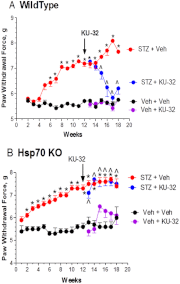Diabetic peripheral neuropathy: should a chaperone accompany our therapeutic approach?
- PMID: 22885705
- PMCID: PMC3462992
- DOI: 10.1124/pr.111.005314
Diabetic peripheral neuropathy: should a chaperone accompany our therapeutic approach?
Abstract
Diabetic peripheral neuropathy (DPN) is a common complication of diabetes that is associated with axonal atrophy, demyelination, blunted regenerative potential, and loss of peripheral nerve fibers. The development and progression of DPN is due in large part to hyperglycemia but is also affected by insulin deficiency and dyslipidemia. Although numerous biochemical mechanisms contribute to DPN, increased oxidative/nitrosative stress and mitochondrial dysfunction seem intimately associated with nerve dysfunction and diminished regenerative capacity. Despite advances in understanding the etiology of DPN, few approved therapies exist for the pharmacological management of painful or insensate DPN. Therefore, identifying novel therapeutic strategies remains paramount. Because DPN does not develop with either temporal or biochemical uniformity, its therapeutic management may benefit from a multifaceted approach that inhibits pathogenic mechanisms, manages inflammation, and increases cytoprotective responses. Finally, exercise has long been recognized as a part of the therapeutic management of diabetes, and exercise can delay and/or prevent the development of painful DPN. This review presents an overview of existing therapies that target both causal and symptomatic features of DPN and discusses the role of up-regulating cytoprotective pathways via modulating molecular chaperones. Overall, it may be unrealistic to expect that a single pharmacologic entity will suffice to ameliorate the multiple symptoms of human DPN. Thus, combinatorial therapies that target causal mechanisms and enhance endogenous reparative capacity may enhance nerve function and improve regeneration in DPN if they converge to decrease oxidative stress, improve mitochondrial bioenergetics, and increase response to trophic factors.
Figures






Similar articles
-
Promoting Neuronal Tolerance of Diabetic Stress: Modulating Molecular Chaperones.Int Rev Neurobiol. 2016;127:181-210. doi: 10.1016/bs.irn.2016.03.001. Epub 2016 Apr 5. Int Rev Neurobiol. 2016. PMID: 27133150 Free PMC article. Review.
-
How inflammation dictates diabetic peripheral neuropathy: An enlightening review.CNS Neurosci Ther. 2024 Apr;30(4):e14477. doi: 10.1111/cns.14477. Epub 2023 Oct 5. CNS Neurosci Ther. 2024. PMID: 37795833 Free PMC article. Review.
-
Emerging drugs for diabetic neuropathy.Expert Opin Emerg Drugs. 2010 Dec;15(4):661-83. doi: 10.1517/14728214.2010.512610. Epub 2010 Aug 27. Expert Opin Emerg Drugs. 2010. PMID: 20795891 Review.
-
New perspectives in diabetic neuropathy.Neuron. 2023 Sep 6;111(17):2623-2641. doi: 10.1016/j.neuron.2023.05.003. Epub 2023 May 31. Neuron. 2023. PMID: 37263266 Free PMC article. Review.
-
Burning through the pain: treatments for diabetic neuropathy.Diabetes Obes Metab. 2015 Dec;17(12):1115-25. doi: 10.1111/dom.12535. Epub 2015 Sep 10. Diabetes Obes Metab. 2015. PMID: 26179288 Review.
Cited by
-
Melatonin Prevents Oxidative Stress-Induced Mitochondrial Dysfunction and Apoptosis in High Glucose-Treated Schwann Cells via Upregulation of Bcl2, NF-κB, mTOR, Wnt Signalling Pathways.Antioxidants (Basel). 2019 Jun 26;8(7):198. doi: 10.3390/antiox8070198. Antioxidants (Basel). 2019. PMID: 31247931 Free PMC article.
-
The Relationship between Plasma Taurine Levels and Diabetic Complications in Patients with Type 2 Diabetes Mellitus.Biomolecules. 2019 Mar 11;9(3):96. doi: 10.3390/biom9030096. Biomolecules. 2019. PMID: 30862074 Free PMC article.
-
Mesenchymal stem cell-based treatment for microvascular and secondary complications of diabetes mellitus.Front Endocrinol (Lausanne). 2014 Jun 6;5:86. doi: 10.3389/fendo.2014.00086. eCollection 2014. Front Endocrinol (Lausanne). 2014. PMID: 24936198 Free PMC article. Review.
-
Cell-derived exosome therapy for diabetic peripheral neuropathy: a preclinical animal studies systematic review and meta-analysis.Stem Cell Res Ther. 2025 Jun 9;16(1):297. doi: 10.1186/s13287-025-04432-0. Stem Cell Res Ther. 2025. PMID: 40490808 Free PMC article. Review.
-
Antioxidation and anti-inflammatory activity of Tang Bi Kang in rats with diabetic peripheral neuropathy.BMC Complement Altern Med. 2015 Mar 18;15:66. doi: 10.1186/s12906-015-0600-0. BMC Complement Altern Med. 2015. PMID: 25887432 Free PMC article.
References
-
- Abbas ZG, Swai AB. (1997) Evaluation of the efficacy of thiamine and pyridoxine in the treatment of symptomatic diabetic peripheral neuropathy. East Afr Med J 74:803–808 - PubMed
-
- PKC-DRS2 Group, Aiello LP, Davis MD, Girach A, Kles KA, Milton RC, Sheetz MJ, Vignati L, Zhi XE. (2006) Effect of ruboxistaurin on visual loss in patients with diabetic retinopathy. Ophthalmology 113:2221–2230 - PubMed
-
- Akkina SK, Patterson CL, Wright DE. (2001) GDNF rescues nonpeptidergic unmyelinated primary afferents in streptozotocin-treated diabetic mice. Exp Neurol 167:173–182 - PubMed
Publication types
MeSH terms
Substances
Grants and funding
LinkOut - more resources
Full Text Sources
Medical

